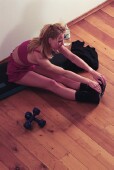
WEDNESDAY, Feb. 5, 2014 (HealthDay News) — Watching the Winter Olympics in Sochi may inspire some to get off the couch and begin working out or playing sports, but it’s important to ease into these activities, an expert suggests.
“Just watching these events can serve as a tremendous inspiration to shape up, change or start a physical activity or sports regimen,” Jim Thornton, president of the National Athletic Trainers’ Association, said in a news release from the group.
“So many of us across the country have been cooped up by this sub-freezing season and are ready to get outside and champion what we’ve been seeing on the elite playing field,” he noted.
But hitting the gym, field or arena and immediately going full-speed isn’t a good idea. You need to start slowly when beginning new activities, using new muscles and challenging your physical and mental skills, Thornton advised.
Your first step should be a physical examination.
“Anyone enjoying a new activity should have a pre-participation exam to determine their readiness to play and uncover any condition that may limit participation,” Thornton said. “If the individual has any pre-existing conditions, it’s important to share that with his or her doctor for review and to determine activities that are appropriate.”
Be sure to dress for the weather, eat a balanced diet and drink enough water during and after your activity. It’s also important to give your body time to warm up, cool down, and to rest and recover between workouts.
“If you’ve started a new regimen or been doing a lot of one type of activity, such as running, mix it up,” Thornton suggested. “Take a rest day and then try swimming or weightlifting or a sport that uses different muscles to avoid repetitive motion.”
If you suffer an injury or feel a “ping” or “popping sound,” stop exercising or playing sports and see a doctor.
Among Thornton’s other suggestions:
- Check if health clubs and other facilities you’re using have automated external defibrillators (a device that checks and can restore heart rhythm) and people on-site who know how to use them. Ask if there is an emergency action plan.
- Follow sports injury prevention advice and make sure equipment is in working order and safe.
- Take steps to protect yourself from bacterial, viral and fungal infections. Check that gyms, locker rooms and shower surfaces are clean. Do not share towels, disposable razors, hair clippers, water bottles or athletic gear.
More information
The U.S. National Heart, Lung, and Blood Institute offers a guide to physical activity.
Copyright © 2024 HealthDay. All rights reserved.

